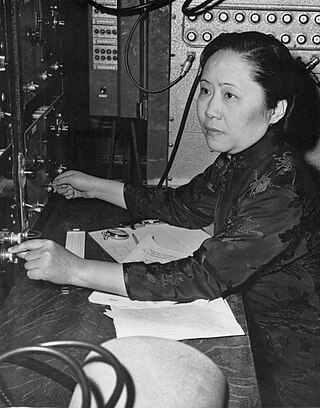
In nuclear physics, beta decay (β-decay) is a type of radioactive decay in which an atomic nucleus emits a beta particle, transforming into an isobar of that nuclide. For example, beta decay of a neutron transforms it into a proton by the emission of an electron accompanied by an antineutrino; or, conversely a proton is converted into a neutron by the emission of a positron with a neutrino in so-called positron emission. Neither the beta particle nor its associated (anti-)neutrino exist within the nucleus prior to beta decay, but are created in the decay process. By this process, unstable atoms obtain a more stable ratio of protons to neutrons. The probability of a nuclide decaying due to beta and other forms of decay is determined by its nuclear binding energy. The binding energies of all existing nuclides form what is called the nuclear band or valley of stability. For either electron or positron emission to be energetically possible, the energy release or Q value must be positive.

A muon is an elementary particle similar to the electron, with an electric charge of −1 e and a spin of 1⁄2, but with a much greater mass. It is classified as a lepton. As with other leptons, the muon is not thought to be composed of any simpler particles; that is, it is a fundamental particle.

The neutron is a subatomic particle, symbol
n
or
n0
, which has a neutral charge, and a mass slightly greater than that of a proton. Protons and neutrons constitute the nuclei of atoms. Since protons and neutrons behave similarly within the nucleus, and each has a mass of approximately one dalton, they are both referred to as nucleons. Their properties and interactions are described by nuclear physics. Protons and neutrons are not elementary particles; each is composed of three quarks.

A neutrino is a fermion that interacts only via the weak interaction and gravity. The neutrino is so named because it is electrically neutral and because its rest mass is so small (-ino) that it was long thought to be zero. The rest mass of the neutrino is much smaller than that of the other known elementary particles excluding massless particles. The weak force has a very short range, the gravitational interaction is extremely weak due to the very small mass of the neutrino, and neutrinos do not participate in the strong interaction. Thus, neutrinos typically pass through normal matter unimpeded and undetected.
The Greisen–Zatsepin–Kuzmin limit (GZK limit or GZK cutoff) is a theoretical upper limit on the energy of cosmic ray protons traveling from other galaxies through the intergalactic medium to our galaxy. The limit is 5×1019 eV (50 EeV), or about 8 joules (the energy of a proton travelling at ≈ 99.99999999999999999998% the speed of light). The limit is set by the slowing effect of interactions of the protons with the microwave background radiation over long distances (≈ 160 million light-years). The limit is at the same order of magnitude as the upper limit for energy at which cosmic rays have experimentally been detected, although indeed some detections appear to have exceeded the limit, as noted below. For example, one extreme-energy cosmic ray, the Oh-My-God Particle, which has been found to possess a record-breaking 3.12×1020 eV (50 joules) of energy (about the same as the kinetic energy of a 95 km/h baseball).

In nuclear physics, double beta decay is a type of radioactive decay in which two neutrons are simultaneously transformed into two protons, or vice versa, inside an atomic nucleus. As in single beta decay, this process allows the atom to move closer to the optimal ratio of protons and neutrons. As a result of this transformation, the nucleus emits two detectable beta particles, which are electrons or positrons.

In physical cosmology, the baryon asymmetry problem, also known as the matter asymmetry problem or the matter–antimatter asymmetry problem, is the observed imbalance in baryonic matter and antibaryonic matter in the observable universe. Neither the standard model of particle physics nor the theory of general relativity provides a known explanation for why this should be so, and it is a natural assumption that the universe is neutral with all conserved charges. The Big Bang should have produced equal amounts of matter and antimatter. Since this does not seem to have been the case, it is likely some physical laws must have acted differently or did not exist for matter and antimatter. Several competing hypotheses exist to explain the imbalance of matter and antimatter that resulted in baryogenesis. However, there is as of yet no consensus theory to explain the phenomenon, which has been described as "one of the great mysteries in physics".

Muon spin spectroscopy, also known as µSR, is an experimental technique based on the implantation of spin-polarized muons in matter and on the detection of the influence of the atomic, molecular or crystalline surroundings on their spin motion. The motion of the muon spin is due to the magnetic field experienced by the particle and may provide information on its local environment in a very similar way to other magnetic resonance techniques, such as electron spin resonance and, more closely, nuclear magnetic resonance (NMR).

The Mainz Microtron, abbreviated MAMI, is a microtron which provides a continuous wave, high intensity, polarized electron beam with an energy up to 1.6 GeV. MAMI is the core of an experimental facility for particle, nuclear and X-ray radiation physics at the Johannes Gutenberg University in Mainz (Germany). It is one of the largest campus-based accelerator facilities for basic research in Europe. The experiments at MAMI are performed by about 200 physicists of many countries organized in international collaborations.
In particle physics, the Peskin–Takeuchi parameters are a set of three measurable quantities, called S, T, and U, that parameterize potential new physics contributions to electroweak radiative corrections. They are named after physicists Michael Peskin and Tatsu Takeuchi, who proposed the parameterization in 1990; proposals from two other groups came almost simultaneously.

Photodisintegration is a nuclear process in which an atomic nucleus absorbs a high-energy gamma ray, enters an excited state, and immediately decays by emitting a subatomic particle. The incoming gamma ray effectively knocks one or more neutrons, protons, or an alpha particle out of the nucleus. The reactions are called (γ,n), (γ,p), and (γ,α).

Zero- to ultralow-field (ZULF) NMR is the acquisition of nuclear magnetic resonance (NMR) spectra of chemicals with magnetically active nuclei in an environment carefully screened from magnetic fields. ZULF NMR experiments typically involve the use of passive or active shielding to attenuate Earth’s magnetic field. This is in contrast to the majority of NMR experiments which are performed in high magnetic fields provided by superconducting magnets. In ZULF experiments the dominant interactions are nuclear spin-spin couplings, and the coupling between spins and the external magnetic field is a perturbation to this. There are a number of advantages to operating in this regime: magnetic-susceptibility-induced line broadening is attenuated which reduces inhomogeneous broadening of the spectral lines for samples in heterogeneous environments. Another advantage is that the low frequency signals readily pass through conductive materials such as metals due to the increased skin depth; this is not the case for high-field NMR for which the sample containers are usually made of glass, quartz or ceramic.

Ultracold neutrons (UCN) are free neutrons which can be stored in traps made from certain materials. The storage is based on the reflection of UCN by such materials under any angle of incidence.
CryoEDM is a particle physics experiment aiming to measure the electric dipole moment (EDM) of the neutron to a precision of ~10−28ecm. The name is an abbreviation of cryogenic neutron EDM experiment. The previous name nEDM is also sometimes used, but should be avoided where there may be ambiguity. The project follows the Sussex/RAL/ILL nEDM experiment, which set the current best upper limit of 2.9×10−26ecm. To reach the improved sensitivity, cryoEDM uses a new source of ultracold neutrons (UCN), which works by scattering cold neutrons in superfluid helium.

Modern searches for Lorentz violation are scientific studies that look for deviations from Lorentz invariance or symmetry, a set of fundamental frameworks that underpin modern science and fundamental physics in particular. These studies try to determine whether violations or exceptions might exist for well-known physical laws such as special relativity and CPT symmetry, as predicted by some variations of quantum gravity, string theory, and some alternatives to general relativity.

Spherical Neutral Detector is a detector for particle physics experiments, successor of the Neutral Detector (ND), created by the team of physicists in the Budker Institute of Nuclear Physics (BINP), Novosibirsk, Russia. There are three major periods in evolution of the SND experiment;

The Wu experiment was a particle and nuclear physics experiment conducted in 1956 by the Chinese American physicist Chien-Shiung Wu in collaboration with the Low Temperature Group of the US National Bureau of Standards. The experiment's purpose was to establish whether or not conservation of parity (P-conservation), which was previously established in the electromagnetic and strong interactions, also applied to weak interactions. If P-conservation were true, a mirrored version of the world (where left is right and right is left) would behave as the mirror image of the current world. If P-conservation were violated, then it would be possible to distinguish between a mirrored version of the world and the mirror image of the current world.
Searches for Lorentz violation involving photons provide one possible test of relativity. Examples range from modern versions of the classic Michelson–Morley experiment that utilize highly stable electromagnetic resonant cavities to searches for tiny deviations from c in the speed of light emitted by distant astrophysical sources. Due to the extreme distances involved, astrophysical studies have achieved sensitivities on the order of parts in 1038.

Angular Correlation of Electron Positron Annihilation Radiation (ACAR or ACPAR) is a technique of solid state physics to investigate the electronic structure of metals. It uses positrons which are implanted into a sample and annihilate with the electrons. In the majority of annihilation events, two gamma quanta are created that are, in the reference frame of the electron-positron pair, emitted in exactly opposite directions. In the laboratory frame, there is a small angular deviation from collinearity, which is caused by the momentum of the electron. Hence, measuring the angular correlation of the annihilation radiation yields information about the momentum distribution of the electrons in the solid.

Volker D. Burkert is a German physicist, academic and researcher. He is a Principal Staff Scientist at the Thomas Jefferson National Accelerator Facility at Jefferson Lab (JLab) in Newport News, Virginia (USA). He has made major contributions to the design of the CEBAF Large Acceptance Spectrometer (CLAS) that made it suitable for high luminosity operation in experiments studying spin-polarized electron scattering.



















